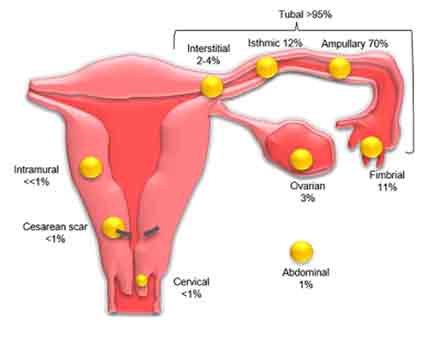13th Decemer 2022, NIA Diagnostic Imaging

Pelvic pain is a common presentation in general practice. It becomes a little bit more complicated if that occurs during the first trimester of pregnancy. To the usual gynaecological and non-gynaecological causes, we have to add the other obstetric causes of pelvic pain. The obstetric causes during the 1st trimester can be a serious concern and should be treated as an urgent matter. Often we need to order an urgent pelvic ultrasound. NIA Diagnostic Imaging always prioritise urgent pregnancy cases by offering same-day appointments and reports. They also have a team of highly knowledgeable male and female sonographers and radiologists who specialise in women’s imaging to deliver accurate and fast diagnosis.
Different diagnoses for pelvic pain in the 1st trimester includes:
- Subchorionic hemorrhage*
- Spontaneous abortion*
- Molar pregnancy
- Benign ovarian cyst
- Corpus luteam*
- Follicular
- Haemorrhagic
- Endometriotic
- Haemoperitoneum
- Ectopic pregnancy*
- Ovarian hyperstimulation
- Ovarian torsion
- Leiomyoma (Fibroids)
- Urinary tract
- Hydronephrosis
- Cystitis
- Pyelonephritis
- Nephrolithiasis (renal stones)
- Gastrointestinal
- Appendicitis
- Crohn’s disease
- Bowel obstruction
(Eyvazzadeh & Levine, 2006) (Masselli, et al., 2014)
From the above list, the ones with an asterisk will be the ones we will discuss further.
Subchorionic Haemorrhage Aetiology
Subchorionic haemorrhages is bleeding under the chorion membranes and occurs when the trophoblast partially detaches from the uterine wall (Bondick, et al., 2021).
The causes of subchorionic haemorrhages are still unclear. However, malformations of the uterus, history of miscarriages or pelvic infections are factors that can contribute to a subchorionic haemorrhage (Bondick, et al., 2021).
Pathology/Pathophysiology
It is suggested that subchorionic haemorrhages occurs when the utero-placental veins tear and leads to low pressure bleeding that tracks around the gestational sac and forms a crescent-shaped haematoma between the chorion membrane and uterine wall (Zhen, 2017).
Ectopic Pregnancy Aetiology

Ectopic pregnancies occurs when a blastocyst implants outside of the endometrial canal.
The risk factors include history of ectopic pregnancy, tubal surgery, and pelvic inflammatory disease (University of Washington, 2022).
Pathology/Pathophysiology
After 6 to 16 weeks, the structure containing the foetus ruptures and this rupture can gradually or rapidly cause haemorrhagic shock. A delayed rupture can lead to more rapid blood lost and higher risk of death (Dulay, 2020).
97% of ectopic pregnancies occur in the fallopian tubes. However, they can also be found elsewhere, and this is well demonstrated in Figure 1.
Spontaneous Abortion Aetiology
Spontaneous abortion is the natural loss of pregnancy before 20 weeks gestation and occurs in 10-12% of clinically recognised pregnancies (Alves & Rapp, 2021) (Eyvazzadeh & Levine, 2006). It is believed that in 50% of cases, it is because of foetal chromosomal abnormalities that lead to spontaneous abortions (Alves & Rapp, 2021).
Pathology/Pathophysiology
Spontaneous abortions can be categorised in 5 forms:
- Threatened miscarriage: bleeding in the first 20 weeks of gestation with a closed internal os (Eyvazzadeh & Levine, 2006)
- Missed miscarriage: non-viable intrauterine foetus with no symptoms of a miscarriage (Weerakkody, 2022)
- Inevitable miscarriage: bleeding in the first 20 weeks of gestation with an open internal os. In this case, the gestational sac may be seen low lying within the uterus and will need serial ultrasound to observe migration progress (Jones, 2021)
- Incomplete miscarriage: intrauterine miscarriage where the retained product of conception is still within the uterus (Jones, 2021)
- Complete miscarriage: intrauterine miscarriage where there are no retained products of conception within the uterus and vaginal bleeding has ceased (Jones, 2021)
Corpus Luteum Aetiology
A corpus luteum is an ovarian cyst that forms during the luteal phase.
When the corpus luteal cyst undergoes haemorrhage, twists or ruptures, these occurrences can cause pelvic pain for the patient (Eyvazzadeh & Levine, 2006).
Pathology/Pathophysiology
Once the cyst is formed, blood fills the cyst and eventually forms a haemorrhagic corpus luteal cyst which may rupture. When the corpus luteal cyst ruptures, it leads to internal bleeding in the peritoneal cavity and this bleeding irritates the surrounding anatomy and leads to pelvic pain (Medvediev, et al., 2020).
At NIA Diagnostic Imaging, they thrive to put in time to thoroughly investigate the source of the problem and provide the most accurate diagnosis.

References
Alves, C & Rapp, A 2021, Spontaneous Abortion, StatPearls Publishing, Treasure Island, Florida.
Bondick, C, Das, J & Fertel, H 2021, Subchorionic Hemorrhage, StatPearls Publishing, Treasure Island, Florida. Dulay, A 2020, Ectopic Pregnancy, MSD Manual, New York, USA.
Eyvazzadeh, A & Levine, D 2006, Imaging of Pelvic Pain in the First Trimester of Pregnancy. Radiologic Clinics of North America, vol. 44, no. 6, pp. 863-877.
Institute of Obstetricians and Gynaecologists, Royal College of Physicians of Ireland 2010, Ultrasound Diagnosis of Early Pregnancy Miscarriage, Health Service Executive, Dublin, Ireland.
Jones, J 2021, Complete miscarriage, viewed 10 April 2022, <https://radiopaedia.org/articles/complete- miscarriage?lang=gb>.
Jones, J 2021, Incomplete miscarriage, viewed 10 April 2022, <https://radiopaedia.org/articles/incomplete- miscarriage?lang=gb>.
Jones, J 2021, Inevitable miscarriage, viewed 10 April 2022, <https://radiopaedia.org/articles/inevitable- miscarriage?lang=gb>.
Lin, E, Bhatt, S & Dogra, V 2008, Diagnostic Clues to Ectopic Pregnancy. Radiographics, vol. 28, no. 6, pp. 1661-1671. Masselli, G. et al 2014, Imaging for acute pelvic pain in pregnancy. Insights Imaging, vol. 5, no. 2, pp. 165-181.
Medvediev, M. V, Malvasi, A, Gustapane, S & Tinelli, A 2020, Hemorrhagic corpus luteum: Clinical management update.
Turkish Journal Of Obstetrics And Gynecology, vol. 17, no. 4, pp. 300-309.
Ucisik-Keser, F. E. et al 2021, The many faces of ectopic pregnancies: demystifying the common and less common entities. Abdominal Radiology, vol. 46, no. 3, pp. 1104-1114.
University of Washington, 2022, Department of Radiology, viewed 10 April 2022, <https://rad.washington.edu/body- teaching-files/23742/>.
Weerakkody, Y 2022, Missed miscarriage, viewed 10 April 2022, <https://radiopaedia.org/articles/missed- miscarriage-2?lang=gb>
Zhen, L. D 2017, Effects of subchorionic haematoma on pregnancy outcomes, Australian Medical Student Journal, Melbourne, Australia.
